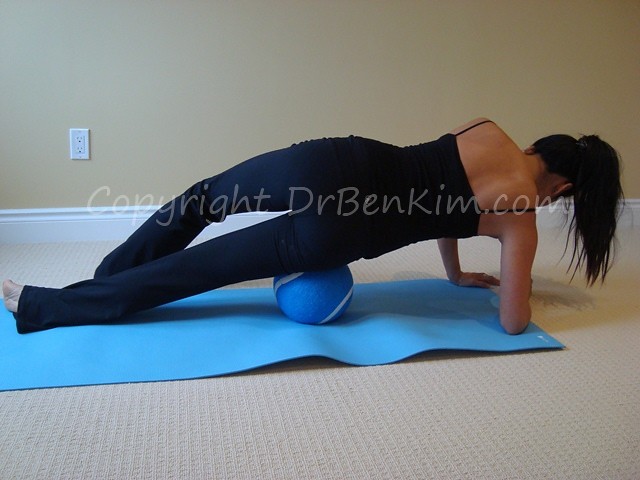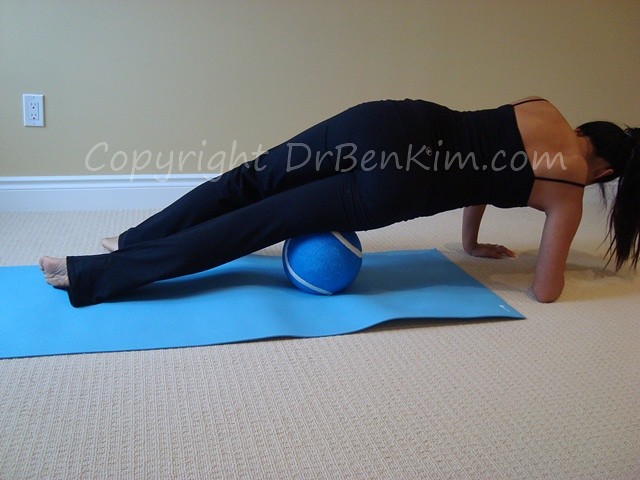You are here
How to Foam Roll Your Iliotibial Band (IT Band)
 One of the most important principles taught in chiropractic school is that every joint in the body is affected by the health of adjacent joints.
One of the most important principles taught in chiropractic school is that every joint in the body is affected by the health of adjacent joints.
Put another way, when a patient presents with a knee problem, it's prudent to do a thorough evaluation of the knee, hip, and ankle regions, as sometimes, dysfunction in the ankle or hip can be a root cause of knee pain and dysfunction.
And to take things further, it never hurts to evaluate gait and overall health to make sure that all major joints are functioning properly; purely due to the biomechanical design of your body, lack of or excessive mobility in the joints within your feet and ankles can actually cause dysfunction all the way up in your spine as your body is forced to make compensatory changes over time.

Anatomy of Your IT Band
Your IT band originates from your pelvic region, where it's meshed together with a muscle called your tensor fascia latae and even a bit of your gluteus maximus.
From your outer hip region, your IT band travels down the outside part of your thigh and inserts into the top of your shin bone. If you palpate the side of your thigh right above your knee joint, you'll locate a tight band of tissue that is larger than a typical tendon and more firm than a well developed muscle - this is part of your IT band.
Your IT band can become tight and even inflamed for any number of reasons, some of which include:
-
Repeated walking or running on uneven terrain.
-
Training on a track or the edge of road that is slightly graded to one side, causing the iliotibial band of your downhill leg to experience extra stress.
-
Engaging in high level athletic activities without proper form.
-
Being overweight and/or suddenly gaining weight, including that of pregnancy, where your IT band experiences excessive strain.
IT band tightness is quite common, and most often manifests as pain in the outer, lower thigh region, just above the knee joint. With a tight IT band, you can expect to have some level of dysfunction in your hip and knee, if not now, then sometime in the future.
In your hip region, a tight IT band is sometimes caused by weak hip abductors or hip flexors, as weakness in these muscles can cause your tensor fascia latae to overwork, which creates excessive upward strain on your IT band.
In your knee, a tight IT band can cause your anterior and posterior cruciate ligaments to experience more load whenever your knee joints are stressed, which increases risk of experiencing a sprain or even a tear of one of these ligaments.
Bottom line: if you're looking to stay healthy and mobile, regardless of your age, you can stand to benefit from keeping your IT bands healthy.
How to Foam Roll Your IT Band
To promote healthy IT bands, you'll need a foam roller or a jumbo tennis ball (or volleyball). Since the IT band is usually quite tender to pressure, I typically start my patients on a jumbo tennis ball.
Start by lying on your side, support your body weight with your legs and arms, and lie with a foam roller or ball under the upper, outside portion of your thigh - this is the proximal portion of your IT band.
Use your legs and arms to roll the length of your IT band along the ball, traveling right down to just above your knee joint. As you get closer to your knee, you may feel more tenderness, so be prepared to use your arms and legs to ease pressure off of your IT band.
Roll back towards the upper portion of your IT band, and continue back and forth in this fashion for a few passes.
Maintain steady breathing, and feel free to linger and increase pressure whenever you come to points that are especially taut or tender.
Switch from leg to leg between sets to ensure that both of your IT bands are stripped in this fashion, and when you get to a point where you don't feel that much is being done with a ball, you can try this exercise with a foam roller.
Regular rolling of your IT bands should prevent your knee and hip joints from being unnecessarily stressed as you go about your daily activities. It's an unusual exercise, but typical activities and stretching programs don't tend to address IT bands, so rolling this area should be a high priority in your program of self care and wellness.
Here's a brief video clip that shows how to foam roll your IT band:
Please note that your tensor fascia latae (see picture up top) serves to flex and internally rotate your hip joint, and can be accessed while foam rolling the hip flexor and hip abductor regions. If you need guidance on how to roll these areas, view the following posts:
How to Keep Your Hip Flexors Healthy
How to Foam Roll Your Hip Abductors
If you don't have a foam roller and are looking to invest in one that offers a blend of comfort, durability, and ideal density to provide therapeutic rolling of your muscles and ligaments, please feel free to have a look at the one that I had custom made for our clients here:
For a DVD that presents still photos and video clips that illustrate how to take your body through all of the major stretches and foam rolling exercises you can do to keep your body as healthy as your genetics will allow, have a look here:
Stretching and Foam Rolling DVD, by Sharon Lee and Dr. Ben Kim
Here is a link to a jumbo tennis ball that you can use to roll some of your more sensitive tissues:
And here are more related posts that involve foam rolling to support your health:
How to Stretch and Massage Your Inner Hip Muscles
Join more than 80,000 readers worldwide who receive Dr. Ben Kim's free newsletter
Receive simple suggestions to measurably improve your health and mobility, plus alerts on specials and giveaways at our catalogue
Please Rate This
Highest RatedNo articles have been rated for usefulness recently, please check later. | Related Posts | ||














Comments
Knee and Hip Exercises
I have recently developed problems with my right knee. While these exercises are probably great for someone the size and age of your model, what about older obese people that can't do these. I'd pop the ball or flatten the foam rollers....then couldn't get up off the floor. Seriously, what might you suggest for someone in my situation. Thanks in advance. Be Blessed!!!
Hi Steve, There are different
Hi Steve,
There are different grades of firmness among foam rollers. The one that I recommend is actually pretty firm - I don't imagine that it would fall apart with a good amount of weight on it. I'm about 165 pounds and putting my full weight on the roller isn't close to being a problem; my guess is that it could easily handle double my weight without changing form.
You might contact manufacturers directly and ask them about weight capacity of various rollers.
Hope you're able to give it a go and that it helps.
Ben Kim
Foam Rolling - IT band for hips
I had to give you some feedback on this post - I've been having really bad hip pain for about 3 months now and was finding it hard to get around and sleep too. Then I read your article and bought a foam roller and after just ONE go, my hip lost its stiffness and pain and now, 4 days later (after rolling it every night) I'm almost fully recovered. It's AMAZING - painful to do but worth every second. I have also bought the recommended book on Trigger Point Therapy and now advising my father on possible causes for his dizzy spells and my husband on his sore feet! A very big THANK YOU to Dr Kim for all his generosity in sharing his insights and good sense medicine with us all - in the western world where medicine seems to have lost its way, there is still at least one doctor who still cares about disease prevention and a holistic approach to curing people rather than just throwing pills at symptoms. Thank you again and a very happy 2011 to you and your family. Kate x
Thanks so much for your
Thanks so much for your valued feedback, Kate. So glad to know that foam rolling is helping you like it's helped me and many of my clients. Sometimes, it's just nitty gritty work like foam rolling that leads to improvement in our health, not some magical pill or invasive procedure.
IT Band
I have somehow developed what is apparently IT Band Syndrome and having a hard time with the roller. First of all --- it hurts! to roll. And not only in the area where I need to roll it for the IT Band, but also leaning on the support arm is uncomfortable and causes pain in my shoulder. I don't know if I am doing something wrong, using the wrong roller (mine is a white 36 inch one that is not as firm as some I have seen), or if this is simply not a good solution for my problem.
Any ideas you have are welcome.
I do appreciate your newsletter and all the health tips you share with all of us.
Nancy
yeah it's going to hurt if
yeah it's going to hurt if you've never used a foam roll before. it's not a quick fix, it may take a few days of rolling before you feel better. keep at it, it gets easier.